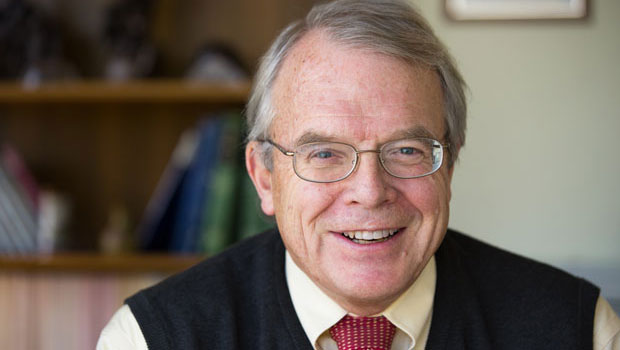What if we could transform society with more equitable health care?

As we approach 2017, Dr. Eric B. Larson writes about what Kaiser Permanente leaders including CEO Bernard Tyson are saying — and reading.
by Eric B. Larson, MD, MPH, Group Health Research Institute (GHRI) executive director, and Group Health vice president for research
Last week, Kaiser Permanente (KP) held a rare meeting of all the leaders of its 200,000 employees and 19,000 physicians serving 10.6 million members. I was one of about 300 people CEO Bernard Tyson addressed when he outlined the organization’s future. Next year, pending insurance commissioner approval, Group Health and GHRI will be part of that vision.
Amidst uncertainty in the national health policy arena, I was struck by a theme at the meeting: KP will press forward, regardless, toward a goal of total health for all.
We will continue to ask, “What if?”
- What if we keep working to expand instead of restrict access to care?
- What if we advocate for schools, work places, and public spaces to be safe and encourage healthy behavior?
- What if, at the same time, we explore scientific advances and technology to treat both common and more complicated conditions?
What if we use technology to reduce disparities?
The discussion on technology particularly resonated because I’m reading a book Bernard mentioned in a recent post. The book is The Fourth Industrial Revolution by Klaus Schwab, founder and executive chair of the World Economic Forum. Schwab writes that in earlier industrial revolutions, we mechanized, scaled up, and automated production. In the fourth revolution, digitization and technology are altering our world even more extensively and rapidly than before.
As I thought of how we gain from these changes, I remembered my first research projects in the 1980s, where we studied a limited number of patients, gathering information on index cards and programming computers with punchcards. Now my research projects include the Electronic Medical Records and Genomics (eMERGE) study, which is demonstrating how to quickly and efficiently gather and process data on 25,000 participants at nine sites around the country. We should celebrate such leaps in technology, Schwab writes, but also be on guard.
Technology can worsen inequality. In many industries, when digitization and automation move in, jobs disappear. This exacerbates income gaps between high-skill and low-skill workers, reducing the strong middle class that has been a defining element of American equality. Connectedness through social media can highlight disparities, stoke resentment, and spread falsehoods. We’ve seen the political friction that follows.
In his book review, Bernard zeroes in on this point. His goal, he writes, is to “provide health coverage and care for nearly 11 million members today — and to prepare a complex organization for a world 10 or 20 years from now.”
Toward the first objective, Bernard specifically addresses inequality and improving health from birth to old age. He writes that KP must be “a place where stigma and disparities are not preventing members from getting the health care they need.” To prepare for the future, he notes Schwab’s message to harness technology for efficiency and equality.
What if GHRI joins the Kaiser Permanente research network?
In joining KP, GHRI will bring knowledge, experience, and a long-term commitment to using data and information technology to improve health and care. We advance analytical methods and electronic innovations not for their own sake but to promote positive, meaningful outcomes for patients.
Through eMERGE, a proof-of-principle big-data initiative, we’re finding sensitive ways to communicate complex medical and genetic information to individuals of all backgrounds and health literacy levels. Other GHRI researchers are working to advance patient-centered technology as well. Senior Investigators Drs. Jennifer McClure and James Ralston, Assistant Investigator Dr. Andrea Hartzler, and Assistant Investigator Dr. Pedja Klasnja are all focusing on projects that electronically connect patients, providers, and health resources. Examples include using mobile phones, which are becoming ubiquitous across age, race/ethnicity, and socioeconomic groups, to deliver health interventions and collect research data. As Schwab urges in his book and Bernard seconds in his review, GHRI is using technology to add value to our members and our community toward a goal of total health and affordable care for all.
Looking ahead to 2017, it’s unclear how the new federal administration may change health care nationally. However, I’m optimistic about Group Health becoming part of KP. I’m ready to ask: What happens when we join this national movement for widely accessible, affordable, high-quality health care? Can the inherent accountability in the Group Health and KP model of integrated care and coverage, which incentivizes keeping members healthy, help families and communities thrive? I believe it can.
No matter what happens in the years ahead, our research teams will continue the innovative work we’ve done for 33 years. We’ll still seek ways to change health care for the better, and maybe soon for millions of KP members.
Happy holidays and see you in the new year.
Also from Group Health Research Institute
GHRI Project Manager Kelly Ehrlich always appreciated study participants’ contributions to research.
Drs. Lin and Holland bring affordable mindfulness-based stress reduction to African American, Latina, and Asian…medium.com


